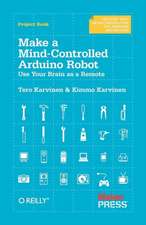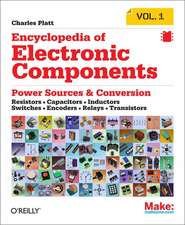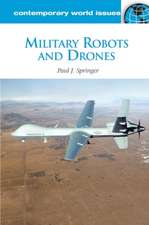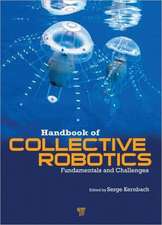Robot Development Using Microsoft Robotics Developer Studio
Autor Shih-Chung Kang, Wei-Tze Chang, Kai-Yuan Gu, Hung-Lin Chien Limba Engleză Hardback – 23 iun 2011
The first several chapters of the book introduce the development environment of MSRDS, including concurrency and coordination runtime (CCR), decentralized software services (DSS), visual simulation environment (VSE), and the Microsoft Visual Programming Language (MVPL). The text then covers the inputs and outputs to the robot and control logic and describes how MSRDS can be used to control a LEGO robot’s hearing and vision. It also presents a real-life example involving a sumo robot contest. The final chapter provides information on related academic courses, websites, and books.
The top-down approach used in this text helps readers think of a robot as a system rather than an assemblage of parts. Readers gain an understanding of methods for integration, design trade-offs, and teamwork—all essential skills for building robots. The MSRDS codes for all examples are available at http://msrds.caece.net/
Preț: 1074.48 lei
Preț vechi: 1444.29 lei
-26% Nou
Puncte Express: 1612
Preț estimativ în valută:
205.63€ • 212.42$ • 171.13£
205.63€ • 212.42$ • 171.13£
Carte tipărită la comandă
Livrare economică 25 martie-08 aprilie
Preluare comenzi: 021 569.72.76
Specificații
ISBN-13: 9781439821657
ISBN-10: 1439821658
Pagini: 288
Ilustrații: 579 b/w images
Dimensiuni: 178 x 254 x 20 mm
Greutate: 0.68 kg
Ediția:New.
Editura: CRC Press
Colecția Chapman and Hall/CRC
ISBN-10: 1439821658
Pagini: 288
Ilustrații: 579 b/w images
Dimensiuni: 178 x 254 x 20 mm
Greutate: 0.68 kg
Ediția:New.
Editura: CRC Press
Colecția Chapman and Hall/CRC
Public țintă
Professional Practice & DevelopmentCuprins
Challenges and Solutions in Robotics. Microsoft Robotics Development Platform. Microsoft Visual Programming Language. Visual Simulation Environment. Robot I/O Unit. Robot Motion Behavior. Controlling the Robot through Sounds. Robot Vision. A Real Application—Sumo Robot Contest. Related Learning Resources. Index.
Notă biografică
Shih-Chung (Jessy) Kang is an associate professor in the Department of Civil Engineering at National Taiwan University (NTU). Dr. Kang began using MSRDS on a research project in 2006 before its official launch by Microsoft and now often teaches about robotics using it. He earned his Ph.D. from Stanford University.
Wei-Tze (Aries) Chang is a postdoctoral researcher at NTU. Dr. Chang is also an adjunct assistant professor in the Department of Civil Engineering at Tamkang University. He earned his Ph.D. from NTU.
Kai-Yuan Gu is a digital design engineer for the Mighty Power Solutions Corp., where he designs automated products for energy-saving devices and lighting. He earned a master’s degree from NTU.
Hung-Lin Chi is a doctoral student in the Department of Civil Engineering at NTU. He is currently researching the integration of robot-sensing techniques into remote-controlled systems for cranes.
Wei-Tze (Aries) Chang is a postdoctoral researcher at NTU. Dr. Chang is also an adjunct assistant professor in the Department of Civil Engineering at Tamkang University. He earned his Ph.D. from NTU.
Kai-Yuan Gu is a digital design engineer for the Mighty Power Solutions Corp., where he designs automated products for energy-saving devices and lighting. He earned a master’s degree from NTU.
Hung-Lin Chi is a doctoral student in the Department of Civil Engineering at NTU. He is currently researching the integration of robot-sensing techniques into remote-controlled systems for cranes.
Recenzii
Readers will appreciate the authors’ step-by-step approach to programming and constructing a basic robot that can interact with the world. This combination of a top-down approach and a step-by-step guide instructs the reader to take a holistic, system-based perspective rather than a traditional functional-component-based one when exploring the construction of an autonomous robot.
—Eric W. Yocam, Computing Reviews, March 2012
—Eric W. Yocam, Computing Reviews, March 2012
Descriere
The Microsoft® Robotics Developer Studio (MSRDS) and LEGO® robots together offer a flexible platform for creating robotic systems. This book provides clear instructions on developing and operating robots. It includes an extensive array of examples and corresponding step-by-step tutorials, with MSRDS codes on a companion website. The top-down approach used in the text helps readers think of a robot as a system rather than an assemblage of parts. Readers gain an understanding of methods for integration, design trade-offs, and teamwork—all essential skills for building robots.















